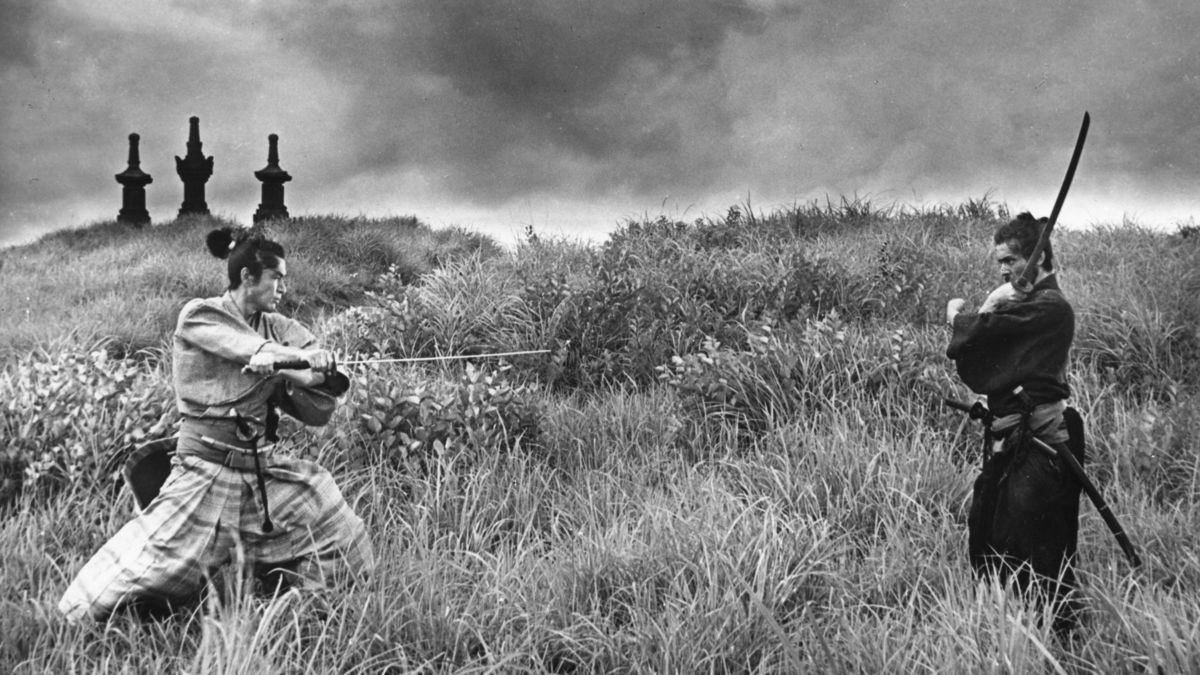In this section of our Colossus Movie Guide for Harakiri, we look at important motifs that help us understand the film.
Cast
- Tatsuya Nakadai – Tsugumo Hanshirō (津雲 半四郎)
- Rentarō Mikuni – Saitō Kageyu (斎藤 勘解由)
- Akira Ishihama – Chijiiwa Motome (千々岩 求女)
- Shima Iwashita – Tsugumo Miho (津雲 美保)
- Tetsurō Tamba – Omodaka Hikokuro (沢潟 彦九郎)
- Ichirō Nakatani – Yazaki Hayato (矢崎 隼人)
- Masao Mishima – Inaba Tango (稲葉 丹後)
- Kei Satō – Fukushima Masakatsu (福島 正勝)
- Yoshio Inaba – Chijiiwa Jinai (千々岩 陣内)
- Yoshiro Aoki – Kawabe Umenosuke (川辺 右馬介)
- Shinobu Hashimoto – Writer
- Masaki Kobayashi – Director
Important motifs in Harakiri
The Topknot
The topknot in Harakiri serves as a critical motif that encapsulates the theme of honor as an external societal expectation. This hairstyle, traditionally worn by samurai, was a symbol of their status and honor. Hanshirō’s act of cutting off the topknots of three samurai signifies an affront to their honor. However, his purpose is not merely to humiliate; it is a calculated action meant to expose the hollowness of such external symbols of honor. The act of revealing the topknots in the courtyard of the Iyi clan is a defiant challenge to the clan’s superficial understanding of honor and Bushido, and an indictment of their rigid, oppressive power structure.
The Bamboo Sword
Motome’s bamboo sword is another potent motif in the film. As a symbol of a samurai’s honor and martial prowess, the fact that Motome’s sword is made of bamboo and not steel is an indictment of his poverty and desperate circumstances. It embodies the bleak reality of lower-class samurais during the era, while also symbolizing the societal neglect and disregard for their plight. When forced to commit seppuku with his bamboo sword, the horrific scene underscores the theme of systemic oppression and the dehumanizing consequences of rigid adherence to abstract ideals of honor.
The Armor
The antique armor, symbolic of the Iyi clan’s heritage and claimed honor, is a recurring motif. It stands as a testament to the clan’s glorified past and their adherence to tradition. However, Hanshirō’s act of smashing the armor during his last stand serves as a powerful act of defiance. It signifies the dismantling of the clan’s illusions of honor and the empty glorification of their past, aligning with the film’s critique of societal norms and hollow interpretations of honor.
The Courtyard
The courtyard of the Iyi clan serves as the stage for key events in Harakiri, from Motome’s tragic forced seppuku to Hanshirō’s defiant showdown. As such, it transforms into a motif symbolizing the arena where the individual confronts the societal system. The very neutrality of this space, where the clan enforces its rules and norms, underscores the themes of power, class disparity, and systemic oppression that run throughout the film. The courtyard bears silent witness to both the physical confrontations and the ideological battles waged within its confines.
Illness
“Illness” is a significant motif, employed by the Iyi clan as a euphemism to cover up the violent deaths inflicted by Hanshirō and to conceal their own dishonor. It’s a metaphor for the clan’s attempts to whitewash their actions and manipulate the narrative, preserving their reputation at the expense of truth and justice. This motif aligns with the film’s exploration of societal manipulation of narratives and the illusion of honor. The recurrence of “illness” as a cause of death in the official records symbolizes the clan’s — and by extension, society’s — determination to uphold false ideals and maintain the status quo, further emphasizing the film’s critique of societal norms.
Share your thoughts
Are there more motifs you think should be part of the Colossus Movie Guide for Harakiri? Leave your thoughts below and we’ll consider them for the guide.

